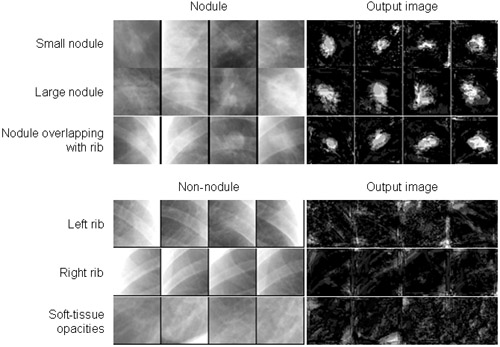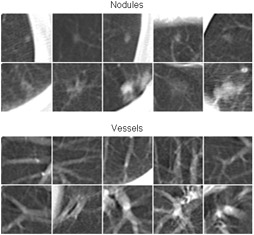
BMAI
バイオメディカルAI研究ユニット

バイオメディカルAI研究ユニット
Ja

We evaluated our virtual dual-energy radiography technique based on a massive-training artificial neural network (MTANN) in the improvement of the conspicuity of nodules in chest radiographs. To do this, we used a validation test database consisting of 118 chest radiographs with pulmonary nodules and an independent test database consisting of 136 digitized screen-film chest radiographs with 136 Read more...

When lung nodules overlap with ribs or clavicles in chest radiographs, it can be difficult for radiologists as well as computer-aided diagnostic (CAD) schemes to detect these nodules. In this study, we developed an image-processing technique for suppressing the contrast of ribs and clavicles in chest radiographs by means of a multi-resolution massive-training artificial neural network (MTANN).< Read more...

We developed a technique that uses a multiple massive-training artificial neural network scheme (multi-MTANN) to reduce false positives (FPs) in a computer-aided diagnostic (CAD) scheme for nodule detection on chest radiographs. Our database consisted of 91 solitary pulmonary nodules including 64 malignant nodules and 27 benign nodules in 91 chest radiographs. With our CAD scheme based on a dif Read more...

Low-dose helical CT (LDCT) is being applied as a modality for lung cancer screening. It may be difficult, however, for radiologists to distinguish malignant from benign nodules in LDCT. Our purpose in this study was to develop a computer-aided diagnostic (CAD) scheme for distinction between benign and malignant nodules in LDCT by use of a massive-training artificial neural network (MTANN). The Read more...

A major challenge in computer-aided diagnostic (CAD) schemes for lung nodule detection in multi-detector-row CT (MDCT) is to reduce false positives (FPs) while maintaining a high sensitivity level. Our purpose in this study was to develop a three-dimensional (3D) massive-training artificial neural network (MTANN) for reduction of FPs. To process quasi-isotropic voxels in the 3D MDCT volume, we Read more...

We extended the capability of a single massive-training artificial neural network (MTANN) and developed a multiple MTANN scheme (multi-MTANN) for further removal of false positives (FPs) in computerized detection of lung nodules in low-dose CT. The multi-MTANN consists of several MTANNs arranged in parallel. Each MTANN is trained by use of the same nodules, but with a different type of non-nodu Read more...

A massive-training artificial neural network (MTANN) is a trainable, highly nonlinear filter consisting of a linear-output multilayer artificial neural network model. For enhancement of nodules and suppression of vessels, we used 10 nodules and 10 non-nodule images as training cases for MTANNs. The MTANN is trained with a large number of input subregions selected from the training cases and the Read more...

We investigated a novel pattern-recognition technique based on an artificial neural network (ANN), called a massive-training artificial neural network (MTANN), for reduction of false positives (FPs) in computerized detection of lung nodules in low-dose CT. The MTANN consists of a linear-output multilayer ANN model, which is capable of operating on image data directly. The MTANN is trained by us Read more...

Enhanced Digital Chest Radiography: Temporal Subtraction Combined with Virtual Dual-EnergyETechnology for Improved Conspicuity of Growing Cancers and Other Pathologic Changes
We developed a novel temporal-subtraction (TS) technique combined with virtual dual-energyEtechnology for improved conspicuity of growing cancers and other pathologic changes in digital chest radiography (CXR). Digi Read more...